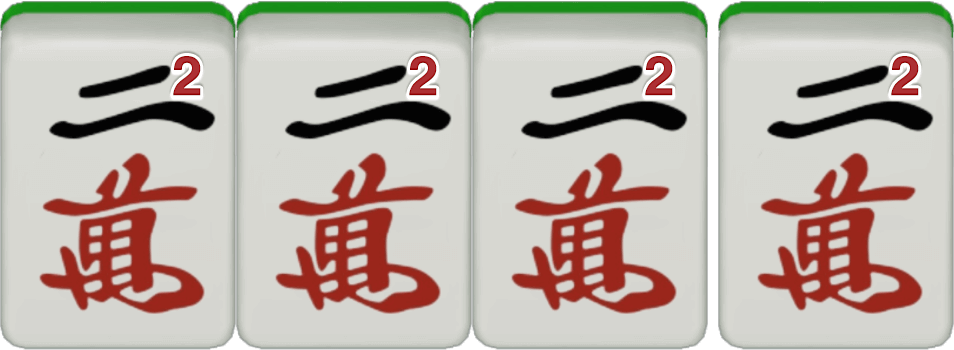Concealed Kong
What Is Concealed Kong
A Concealed Kong in Chinese Mahjong is formed by fully self-drawing four identical tiles, offering a valuable 2-fan bonus—double that of a melded kong. It helps preserve your “concealed” status for additional scoring patterns, can grant extra draws, and seamlessly integrates into pung-based or fully concealed strategies. However, its success hinges on your ability to draw every copy of that tile, which introduces an element of chance and timing. By carefully tracking discards, managing your exposure, and weighing the benefits of concealment versus speed, you can make the most of a Concealed Kong to boost your final score.
The Tile Pattern of Concealed Kong

Four Identical Tiles: The key factor is having all four copies of the same rank/suit (e.g., 5 of Bams ×4) or an honor (e.g., Red Dragon ×4).
Self-Drawn
- You draw every one of these tiles yourself (whether initially forming a concealed pung or drawing the fourth tile later).
- No tile in this kong is claimed from another player’s discard.
Fan Value of Concealed Kong
Under Chinese Mahjong scoring, a Concealed Kong is worth 2 fan. By contrast, a Melded Kong is typically only worth 1 fan. This makes a concealed kong more valuable.
Strategies and Considerations of Concealed Kong
Higher Scoring Potential: At 2 fan, each concealed kong can significantly increase your final score, especially when stacked with other concealed or pung-based patterns.
Extra Draw: Many Chinese Mahjong rules implementations allow you to draw an extra tile from the dead wall when you declare a kong. This can accelerate completion of your hand, possibly enabling more patterns or faster waits.
Maintaining Concealment: Declaring a concealed kong does not turn your hand into an “open” hand, so you can still claim patterns like Concealed Hand or Two Concealed Pungs if you fulfill those requirements.
Drawing All Four Tiles: Relying on self-draw is luck-based and can be slower compared to calling discards to form melds. If you see multiple copies of your tile in others’ hands or discards, you may not complete the kong.
Information Leak: Although a concealed kong remains “concealed,” declaring it still alerts opponents you have all four copies of that tile. They then know that tile is effectively out of circulation, which can inform their strategy.
Potential Conflict with Other Patterns: If you realize you need one of those tiles for a chow or pair-based pattern, grouping all four into a concealed kong can reduce flexibility. Evaluate your overall hand structure to confirm that the kong route is best.
Tracking Tile Availability: If you see an opponent discard the same tile you’re collecting, you lose the chance to keep it fully concealed. Stay vigilant about how many copies remain in the wall.
Timing Your Declaration: You can sometimes wait until late in the hand to declare the upgrade from a concealed pung to a concealed kong, minimizing how much info you give away.
Balancing Speed and Concealment: If you’re far behind in tile progression or facing an opponent close to winning, consider whether going for a concealed kong might be too slow compared to a melded approach (if that were even possible).
LEARN
TOOLS
